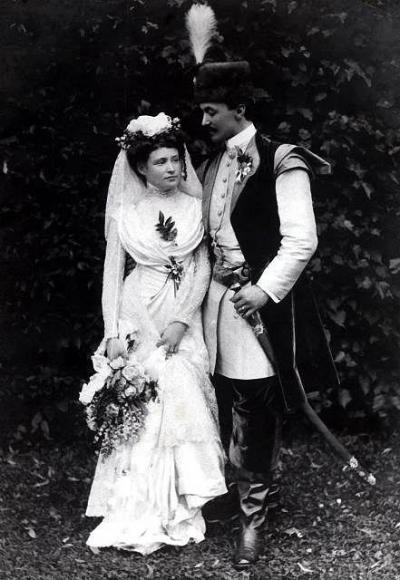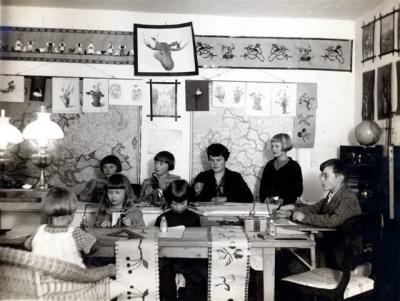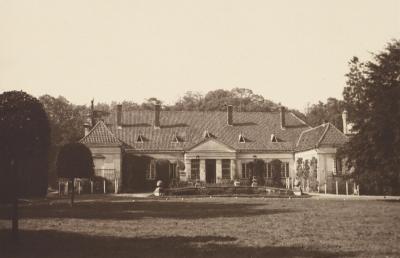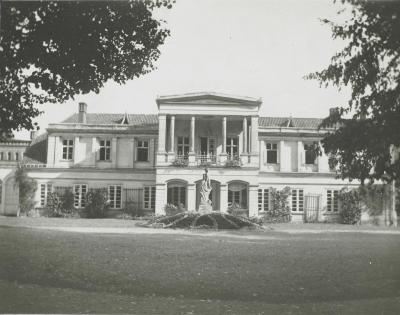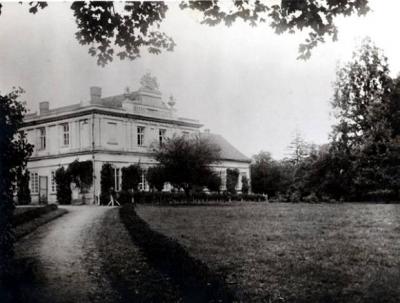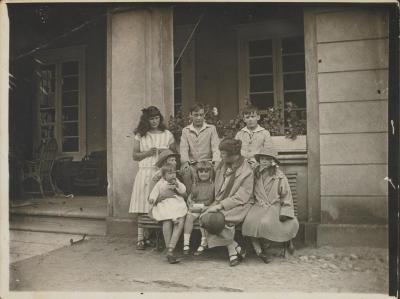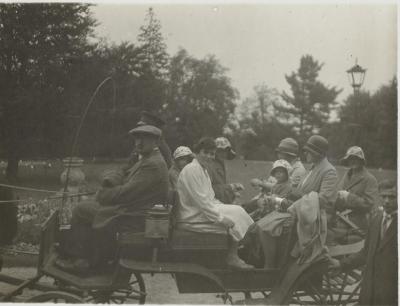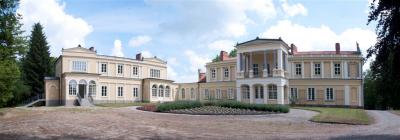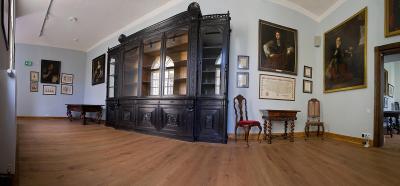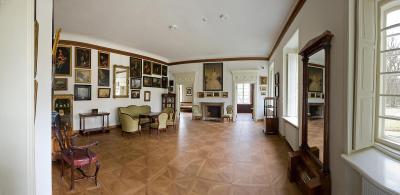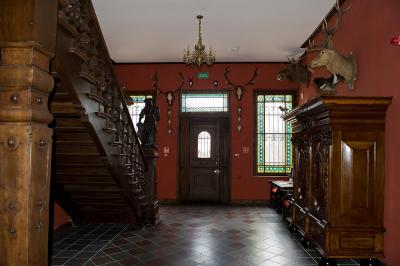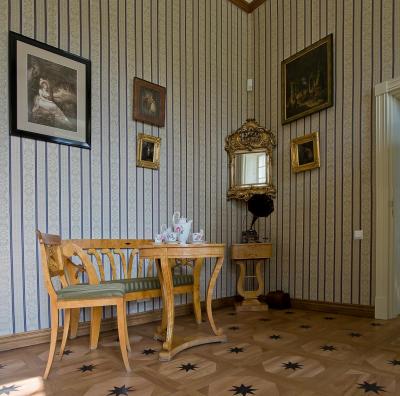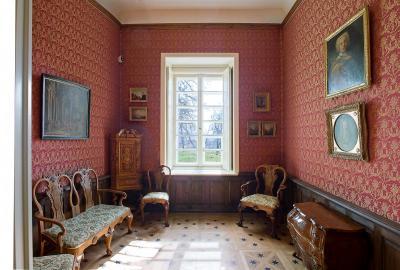Stanisław and Helena Sierakowski. Polish patriots from Waplitz.

A wedding photo taken in 1910 is an important contemporary document: it shows Helena Sierakowski, maiden name Lubomirska, alongside her husband Stanisław, the owner of the Greater Waplitz estate in the Vistula Valley in the district of Sztum, West Prussia (Powiśle). The bride is wearing a beautiful white dress with a veil and train: the bridegroom is wearing a traditional aristocratic uniform with a sabre on his left side. The couple clearly embody the culture and lifestyle of estate owners, a world that was already beginning to disappear at the time. The First World War was to begin four years later and ended with the abolition of the German Empire. However Greater Waplitz did not become a part of the new independent Poland, despite Sierakowski’s efforts to prevent this. In the 1930s the whole of the area around Waplitz was handed over to the Germans. Since the Sierakowskis were important national activists they were imprisoned after the outbreak of the Second World War and murdered shortly afterwards.
The history of the Sierakowski family provides an exemplary chapter in the history of Polish aristocracy over the last 300 years. The family came into the possession of the Greater Waplitz estate in the second half of the 18th century. After the Partitions of Poland the area fell to the Prussians. The Sierakowskis worked doggedly to preserve the national identity and cultural heritage. On account of the continual economic development and the Sierakowski’s social and cultural activities their efforts proved a success. Their descendants laid great value on increasing the economic output of the estate and helped to develop the locality to an important cultural centre. For decades works by European painters were collected and displayed in Waplitz Castle. Furthermore the family built up a significant stock of books and an archive whose contents included the valuable correspondence of Zygmunt Krasiński.
Stanisław Sierakowski was born on 9 March 1881 in Poznań: he was one of three children belonging to Adam und Maria Potocki. Stanisław became interested in politics during his teenage years. He was briefly imprisoned for belonging to a secret organisation known as the Society of Philomats (Towarzystwo Filomatów) at the Catholic grammar school in Chełmno, after which he was expelled. He passed his A-level examinations in Kraków, following which he studied law and economy in Berlin and Brussels. Apart from politics he was also interested in science. Before the First World War he was a member of the Scientific Society (Towarzystwo Naukowe) in Toruń. In 1909 he inherited the ownership of the family estate in Greater Waplitz from his father, alongside the estates in Osiek and Kretki Małe near Brodnica in the district of Rypin.
In 1910 Stanisław married Helena Lubomirska from Przeworsk (Galicia), the daughter of Andrzej Lubomirski, a member of the Galician Parliament and the Vienna Reichstag. Despite her small stature (she stood on a stool for her wedding photo) Helena Sierakowska was a decisive, charismatic, personality.
Years afterwards her grand daughter Izabella Sierakowska-Tomaszewska recalled:
(…) People respected her. She had principles from which she never deviated. She liked to say “One must act as one should”, something which my father later copied. With the exception of a doctor who was a close friend of the family, Germans were only welcomed into the estate office, but never into the salons. People “whose papers were not in order”, i.e. who lived together without having been married in church, were not invited to the family home.
Helena actively supported her husband by undertaking charitable duties in the school system in Warmia and the Vistula Valley. She was particularly interested in Polish lessons for children and young people. She was one of the founders and members of a huge number of organisations including the Society of Christian Women under the Patronage of St. Kunigund (Towarzystwo Kobiet Chrześcijańskich pod wezwaniem świętej Kingi) and the Polish Catholic School Club in the Vistula Valley in Western Prussia (Polsko-Katolickie Towarzystwo Szkolne na Powiślu).
At the end of the First World War Stanisław Sierakowski fought for the inclusion of this area in Poland, and in this connection he appeared in many functions. Around the turn of 1918/19 he was the chairman of the Polish Peoples Council (Rada Ludowa) in Stuhm, and a member of the sub-Commissioner’s office of the supreme People’s Council for the Royal Prussian Regions of Warmia and Masuria, whose headquarters were in Danzig. In December 1918 he was delegated to the Provincial Parliament in Poznan. He fulfilled all these duties in an exemplary fashion, thereby winning the trust of the government in Warsaw who gave him further duties in the following years. In 1919 the Polish government appointed him as head official responsible for the referendum in Warmia and Masuria. In 1920 in 1921 he was the General Consul of the Republic of Poland in Kwidzyn. In 1919 he was one of three Polish experts who took part in the conference at Versailles to prepare the referendum in Warmia, Masuria and the Vistula Valley. During this time he was host to many important personalities from home and abroad in his residence in Waplitz: these included the Apostolic Nuncio in Warsaw, Achille Ratti, the writers Jan Kasprowicz and Stefan Żeromski, and the composer Feliks Nowowiejski. In 1922 Stanisław and Helena Sierakowski were rewarded with the Order of Polonia Restituta for their work in the referendum campaign.
The vote went against Poland and Waplitz was to remain in Germany. True the Sierakowski family, like other estate owners in the Vistula Valley, were given the opportunity of leaving Poland as part of a land exchange, but they refused to do so. Quite the opposite, they increased their efforts to develop the areas of culture and education and committed themselves to improving the condition of Poles in Germany. Helena Sierakowska was one of the cofounders of the League of Poles in Eastern Prussia (Związek Polaków w Prusach Wschodnich), which was created on 30th November 1920 in Olsztyn. The new organisation soon had around 3000 members, of which 1800 came from the Vistula Valley. The following was one of the aims:
To protect the interests of the Polish minority, and strive to improve the welfare of the Polish people (…) especially to promote the League of Poles in their efforts to achieve all its just demands for the Polish inhabitants (…). The League of Poles is the representative of all Poles irrespective of their social class.
In the end calls from Polish circles in Germany for an umbrella organisation became ever louder. In this connection, starting in mid-1921, discussions took place with a variety of organisations in Germany. On 5th June that year a conference of representatives from these organisations took place, in which Poles in Eastern Prussia were represented by Jan Baczewski and Stanisław Sierakowski, a meeting that served to increase Sierakowski’s personal reputation. The upshot was that the participants elected him to discuss matters with further organisations. These discussions lasted for several months and ended with important agreements. Accordingly the BdPiD was set up at a meeting held on 27th August 1922 in Berlin. This was to become the centre of all the organisations in the whole of Germany, which were fighting for a united Poland. The first chairman of the League was Stanisław Sierakowski, who held the office until 1927.
Sierakowski enjoyed the total confidence of the Polish community so that he was given further functions. In 1923 he was elected as a member of the Prussian Parliament, in which he actively participated until December 1924. In February 1923, along with the Polish Member of Parliament, Jan Baczewski, he submitted a formal question on the Polish school system in Germany. From 1923 onwards he belonged to the Presidium of the Association of Polish Organisations and School Clubs (Związekk Polskich Organizacji i Towarzystw Szkolnych).
The foundation of the central organisation of Poles in Germany was a significant act which linked all the Polish organisations in the whole of Germany and allowed them to be an organ for expressing the political will of the Poles over against the German state. From the very start those responsible for the BdPiD sought allies amongst the representatives of other minorities. On the initiative of Stanisław Sierakowski and Jan Baczewski, this resulted in a meeting with representatives of Danish and Sorbian organisations in Greater Waplitz in summer 1923. Following these discussions a conference was arranged to take place on 26th January 1924 in Berlin, where a new institution was set up: the League of National Minorities in Germany, which comprised German citizens of Polish, Danish, Sorbian, Friesian and Czech origin. Lithuanians were also invited to take part in the conference but they did not appear, and only joined the League later in 1927. The first chair of the League was Stanisław Sierakowski. After he relinquished this post in later years, the Dane, Ernst Christiansen, was elected as his successor in 1934. The press organ of the League was the monthly periodical “Kulturwille” (the magazine for minority culture and politics): it was renamed “Kulturwehr” in 1925. Its chief editor was the Upper Lusatian journalist, writer and politician, Jan Skala. Its owner and publisher was the chairman of the League, Stanisław Sierakowski. The periodical quickly became an important forum for communications and the exchange of ideas and experiences between members of national minorities in Germany.
Sierakowski also attempted to strengthen the position of Poles in Germany on the international stage. From 1924 onwards he represented the Polish minority in the League of Nations. One year later, on the grounds of his official duties, he was invited to take part in preparations for a congress of national minorities in Europe. He used this opportunity to protest, amongst others, against demands to revise the conditions of the Treaty of Versailles, and attempted to get the representatives of other minorities in Germany, like the Sorbians, the Friesians and the Lithuanians, to agree to take part in the conference.
Stanisław Sierakowski financed his social and political activities from his own pocket. As a result he and his wife Helena where followed closely by the German authorities for their activities on behalf of Poles in Germany. Indeed, in the second half of the 1990s a German Polish publication appeared containing a comprehensive selection of German documents referring to the status and work of minorities between 1920 in 1939. A lot of space was devoted to the work of the Sierakowskis, not least because it aroused the antagonism of the German authorities, but also of the press.
The second half of the 1920s witnessed the decline of the estate at Greater Waplitz. One of the reasons for this decline was that it was badly run. Stanisław Sierakowski was compelled to take up credits which he was never able to repay. In 1932 he received a demand from the Berlin Zentral-Boden-Kreditbank asking him to repay his liabilities of almost 1,000,000 marks immediately. Subsequently Sierakowski’s rural estate was saved from foreclosure by a loan from the Polish government. Nonetheless this heralded the beginning of the end. The Germans set up a provisional administration and Sierakowski was only allowed to retain a part of his lands, which he subsequently leased. He then took up residence on his Osiek estate near Strasburg, which lay on the Polish side.
After the outbreak of the Second World War and the German occupation of Pommerelia the Sierakowskis were made to leave Osiek and moved to live with their daughter and her husband, Tadeusz Gniazdowski. On 20th October Stanisław Sierakowski was arrested by the Gestapo and thrown into prison in Rypin. Not long afterwards his wife, his daughter and son-in-law suffered the same fate. They were shot at the end of October, respectively the start of November 1939. Their burial place is unknown. The epitaphs of the Sierakowskis can be found in the church in Osiek and the former chapel of the family crypt in the church at Waplitz. The complete estate of the Sierakowskis passed into the hands of the Reich. Their art collection, including all the works by European painters, and their stock of books were scattered to the four winds..
Years later Jan Baczewski, a close colleague of Stanisław Sierakowski, recalled his friend in the following words:
(…) He was treasured and admired by Poles in general. He was fully acquainted with all the cares of members of the Polish community, was sympathetic and fair and, where necessary, was extremely resolute.
Krzysztof Ruchniewicz, February 2017
Sources (amongst others):
Polen und Deutsche zwischen den Krieg. Minderheitenstatus und „Volkstumskampf“ im Grenzgebiet. Amtliche Berichterstattung aus beiden Ländern 1920-1939, edited for the Institute of Conewtmporary History and the directors of the Polish State Archive, by Rudolf Jaworski and Marian Wojciechowski, 1. half-volume, München 1997.
Magdalena Grzebałkowska,Należy postępować, jak należy, [a conversation with Izabella Sierakowska-Tomaszewska, in:] „Gazeta Wyborcza“, 18.02.2008. Digital edition at: http://www.wysokieobcasy.pl/wysokie-obcasy/1,96856,4924397.html (Last consulted on 27.11.2016).
Janusz Hochleitner and Piotr Szwedowski (eds.),Ród Sierakowskich na ziemi malborskiej, Malbork o.J.
Tadeusz Oracki, Sierakowski Stanisław, Polski Słownik Biograficzny [Polish Dictionary of Biography], vol. XXXVII, Heft 2/153, pp. 303-305.Digital edition at: http://www.ipsb.nina.gov.pl/a/biografia/stanislaw-sierakowski (Last consulted on 27.11.2016).
